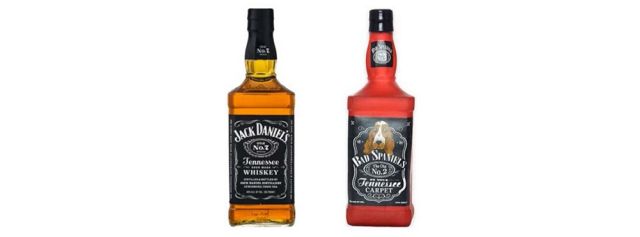In a unanimous decision on June 8, 2023, the Supreme Court held that the First Amendment does not compel a threshold test when the "challenged use of a mark is as a mark." Jack Daniel's Properties, Inc. v. VIP Prods. LLC, No. 22-148, 2023 WL 3872519 (U.S. June 8, 2023). Accordingly, the Court vacated and remanded a Ninth Circuit decision holding that dog toys designed to look like a bottle of Jack Daniel's whiskey did not infringe the trademarks of Jack Daniel's Properties, Inc. ("Jack Daniel's").
The case stems from the creation of a novelty dog toy by VIP Products, LLC ("VIP"), which is visually similar to the design of a Jack Daniel's Old No. 7 Black Label Tennessee Whiskey, replacing Jack Daniel's trademarks such as "Jack Daniel's" and "Old No. 7 Tennessee Sour Mash Whiskey" with "Bad Spaniels" and "Old No. 2 On Your Tennessee Carpet." After receiving a letter from Jack Daniel's, VIP filed a declaratory judgment action.

Jack Daniel's prevailed on its infringement and dilution claims after a bench trial, with the district court finding that consumers were likely to be confused as to the source of the Bad Spaniels toy. However, the Ninth Circuit reversed, determining that the dog toy was "an expressive work" that was protected by the First Amendment and subject to the threshold Rogers test. Under this test, a work is protected under the First Amendment if it is: (i) artistically relevant; and (ii) not explicitly misleading. Rogers v. Grimaldi, 875 F. 2d 994 (2nd Cir. 1989). On remand, the district court found that neither prong of Rogers was satisfied and granted summary judgment to VIP.
In the "narrow" opinion written by Justice Elena Kagan, the Court held that the Rogers test "is not appropriate" when the accused infringer uses a mark as a source identifier because such "use falls within the heartland of trademark law, and does not receive special First Amendment protection." Accordingly, the Court vacated and remanded this decision, specifically noting that it does so without deciding whether Rogers has merits in other contexts. (Three justices in a concurring opinion, however, urged lower courts to "handle" Rogers "with care.")
On a second issue, whether parody is a "noncommercial use" that is always exempt from trademark dilution, the Court again focused on whether the mark was used as a source indicator, holding that the noncommercial exclusion does not shield parodies that have source-identifying functions.
The Supreme Court's decision is welcome news for brand owners enforcing against expressive works, as the Court made clear that when an accused infringer "has used a trademark as a trademark," it does not receive First Amendment protection and is not automatically excluded from dilution liability.
*Spencer Castilla, a summer associate, contributed to this Alert.
The content of this article is intended to provide a general guide to the subject matter. Specialist advice should be sought about your specific circumstances.




